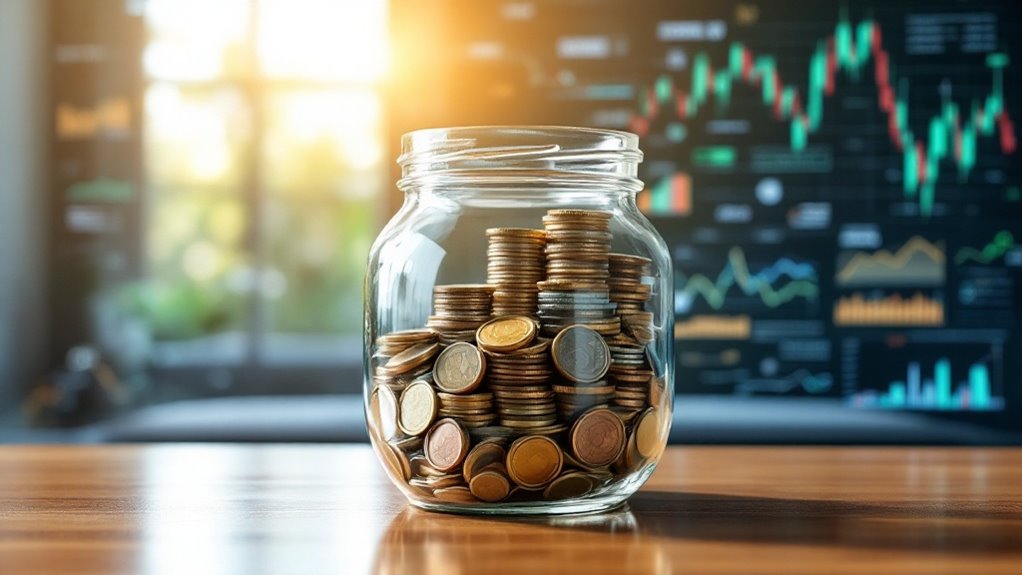Dividends represent a crucial mechanism through which companies distribute profits directly to shareholders, providing both reliable income and insights into corporate financial health. While technology firms often reinvest profits, established sectors like utilities and consumer goods typically offer higher dividend yields, contributing up to 57% of total portfolio returns. Understanding dividend mechanics, from declaration to payment dates, proves essential for strategic investment decisions. The complex interplay between corporate finance and investor returns reveals deeper insights into successful market participation.

While many investors focus primarily on stock price appreciation, understanding dividends represents a significant aspect of building long-term wealth in the stock market. These regular distributions of company profits to shareholders serve as both a reliable income stream and an indicator of corporate financial health, though their implementation varies considerably across different companies and industries.
The mechanics of dividend payments involve a carefully orchestrated sequence of events, beginning with the declaration date when a company's board of directors announces the dividend. Board approval remains a critical requirement before any dividend distribution can occur. This process continues through the essential ex-dividend date, when new buyers no longer qualify for the upcoming payment, and culminates in the actual distribution on the payment date. Research shows that stocks with high dividend yields consistently outperform non-dividend stocks by 1-2% during market downturns.
Dividend payments follow a precise timeline, from board declaration through ex-dividend determination to final shareholder distribution.
The stock price typically adjusts downward by the dividend amount on the ex-dividend date, reflecting the reduction in company assets, though this technical adjustment often gets absorbed into normal price fluctuations.
Over extended periods, total investment returns from dividend-paying stocks can exceed 57% of overall portfolio gains. Dividend investing strategies have evolved beyond simple yield-chasing to encompass sophisticated approaches that balance income with growth potential. While utilities and established consumer goods companies traditionally offer higher yields, technology firms often reinvest profits into growth initiatives rather than distributing them to shareholders.
This dichotomy presents investors with important strategic choices regarding their portfolio composition and income objectives.
The tax implications of dividend investments merit careful consideration, as qualified dividends often receive preferential tax treatment compared to ordinary income. This advantage has contributed to the popularity of dividend-focused investment vehicles, including mutual funds and ETFs, which offer diversified exposure to dividend-paying stocks while simplifying portfolio management.
Companies can distribute dividends in various forms, with cash payments being the most common, though stock dividends and special one-time distributions also play important roles in corporate financial strategies.
The decision to pay dividends reflects a company's maturity, financial stability, and strategic priorities, making dividend policy a significant indicator for investors evaluating potential investments. This complex interplay between corporate finance and investor returns underscores the importance of understanding dividend mechanics in developing a thorough investment strategy.
Frequently Asked Questions
How Do Stock Splits Affect Dividend Payments?
Stock splits fundamentally alter the per-share dividend amount while maintaining the total dividend payout.
When a company executes a split, the dividend per share adjusts proportionally to reflect the new share count. For instance, in a 2-for-1 split, the per-share dividend typically halves, though shareholders receive the same total dividend value due to owning twice as many shares.
Timing matters greatly, as splits occurring before record dates affect upcoming dividend distributions.
Can Foreign Investors Receive Dividends From U.S. Stocks?
Foreign investors can receive dividends from U.S. stocks through direct ownership or ADRs, though specific eligibility conditions must be met.
While the standard dividend withholding tax rate is 30%, bilateral tax treaties often reduce this to 5-15% for qualifying investors.
Proper account setup with brokers and compliance with documentation requirements are essential, as is understanding the interplay between U.S. tax obligations and home country regulations.
What Happens to Dividends During Company Bankruptcy?
During bankruptcy, dividend payments face severe restrictions and complications.
Dividends that were declared but not paid become equity claims, which rank lowest in the payment hierarchy and typically remain unrecoverable.
Courts may scrutinize any dividends paid shortly before bankruptcy as potentially fraudulent transfers, especially if they contributed to insolvency.
Shareholders cannot demand dividend distributions during bankruptcy proceedings, as creditors' claims take absolute priority in asset distribution.
Are Dividend Reinvestment Plans Taxed Differently Than Cash Dividends?
Dividend reinvestment plans (DRPs) and cash dividends are taxed identically in the current tax year, as both constitute taxable income when declared.
However, DRPs offer a distinct advantage in cost basis calculation, as reinvested dividends increase the investment's cost basis, potentially reducing capital gains taxes when shares are eventually sold.
The key difference lies not in immediate taxation but in long-term tax implications and record-keeping requirements.
How Do Preferred Stock Dividends Differ From Common Stock Dividends?
Preferred stock dividends fundamentally differ from common stock dividends in their payment structure and guarantee level.
While preferred dividends offer fixed, predetermined payments that must be distributed before common dividends, common stock dividends remain variable and discretionary.
Preferred stockholders receive priority in dividend payments but typically lack voting rights, whereas common stockholders accept greater uncertainty in dividend amounts but maintain corporate voting privileges.
Additionally, preferred dividends can be cumulative, requiring companies to pay missed dividends before resuming common stock distributions.








